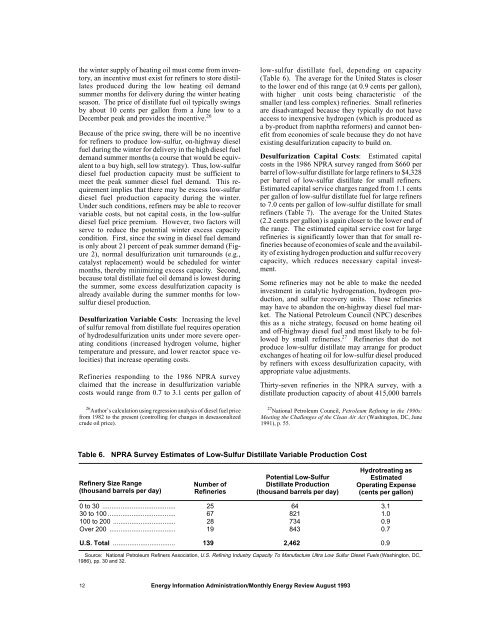Demand, Supply, and Price Outlook for Low-Sulfur Diesel Fuel - EIA
Demand, Supply, and Price Outlook for Low-Sulfur Diesel Fuel - EIA
Demand, Supply, and Price Outlook for Low-Sulfur Diesel Fuel - EIA
Create successful ePaper yourself
Turn your PDF publications into a flip-book with our unique Google optimized e-Paper software.
the winter supply of heating oil must come from inventory,<br />
an incentive must exist <strong>for</strong> refiners to store distillates<br />
produced during the low heating oil dem<strong>and</strong><br />
summer months <strong>for</strong> delivery during the winter heating<br />
season. The price of distillate fuel oil typically swings<br />
by about 10 cents per gallon from a June low to a<br />
December peak <strong>and</strong> provides the incentive. 26<br />
Because of the price swing, there will be no incentive<br />
<strong>for</strong> refiners to produce low-sulfur, on-highway diesel<br />
fuel during the winter <strong>for</strong> delivery in the high diesel fuel<br />
dem<strong>and</strong> summer months (a course that would be equivalent<br />
to a buy high, sell low strategy). Thus, low-sulfur<br />
diesel fuel production capacity must be sufficient to<br />
meet the peak summer diesel fuel dem<strong>and</strong>. This requirement<br />
implies that there may be excess low-sulfur<br />
diesel fuel production capacity during the winter.<br />
Under such conditions, refiners may be able to recover<br />
variable costs, but not capital costs, in the low-sulfur<br />
diesel fuel price premium. However, two factors will<br />
serve to reduce the potential winter excess capacity<br />
condition. First, since the swing in diesel fuel dem<strong>and</strong><br />
is only about 21 percent of peak summer dem<strong>and</strong> (Figure<br />
2), normal desulfurization unit turnarounds (e.g.,<br />
catalyst replacement) would be scheduled <strong>for</strong> winter<br />
months, thereby minimizing excess capacity. Second,<br />
because total distillate fuel oil dem<strong>and</strong> is lowest during<br />
the summer, some excess desulfurization capacity is<br />
already available during the summer months <strong>for</strong> lowsulfur<br />
diesel production.<br />
Desulfurization Variable Costs: Increasing the level<br />
of sulfur removal from distillate fuel requires operation<br />
of hydrodesulfurization units under more severe operating<br />
conditions (increased hydrogen volume, higher<br />
temperature <strong>and</strong> pressure, <strong>and</strong> lower reactor space velocities)<br />
that increase operating costs.<br />
Refineries responding to the 1986 NPRA survey<br />
claimed that the increase in desulfurization variable<br />
costs would range from 0.7 to 3.1 cents per gallon of<br />
26 Author’s calculation using regression analysis of diesel fuel price<br />
from 1982 to the present (controlling <strong>for</strong> changes in deseasonalized<br />
crude oil price).<br />
Refinery Size Range<br />
(thous<strong>and</strong> barrels per day)<br />
Number of<br />
Refineries<br />
low-sulfur distillate fuel, depending on capacity<br />
(Table 6). The average <strong>for</strong> the United States is closer<br />
to the lower end of this range (at 0.9 cents per gallon),<br />
with higher unit costs being characteristic of the<br />
smaller (<strong>and</strong> less complex) refineries. Small refineries<br />
are disadvantaged because they typically do not have<br />
access to inexpensive hydrogen (which is produced as<br />
a by-product from naphtha re<strong>for</strong>mers) <strong>and</strong> cannot benefit<br />
from economies of scale because they do not have<br />
existing desulfurization capacity to build on.<br />
Desulfurization Capital Costs: Estimated capital<br />
costs in the 1986 NPRA survey ranged from $660 per<br />
barrel of low-sulfur distillate <strong>for</strong> large refiners to $4,328<br />
per barrel of low-sulfur distillate <strong>for</strong> small refiners.<br />
Estimated capital service charges ranged from 1.1 cents<br />
per gallon of low-sulfur distillate fuel <strong>for</strong> large refiners<br />
to 7.0 cents per gallon of low-sulfur distillate <strong>for</strong> small<br />
refiners (Table 7). The average <strong>for</strong> the United States<br />
(2.2 cents per gallon) is again closer to the lower end of<br />
the range. The estimated capital service cost <strong>for</strong> large<br />
refineries is significantly lower than that <strong>for</strong> small refineries<br />
because of economies of scale <strong>and</strong> the availability<br />
of existing hydrogen production <strong>and</strong> sulfur recovery<br />
capacity, which reduces necessary capital investment.<br />
Some refineries may not be able to make the needed<br />
investment in catalytic hydrogenation, hydrogen production,<br />
<strong>and</strong> sulfur recovery units. Those refineries<br />
may have to ab<strong>and</strong>on the on-highway diesel fuel market.<br />
The National Petroleum Council (NPC) describes<br />
this as a niche strategy, focused on home heating oil<br />
<strong>and</strong> off-highway diesel fuel <strong>and</strong> most likely to be followed<br />
by small refineries. 27 Refineries that do not<br />
produce low-sulfur distillate may arrange <strong>for</strong> product<br />
exchanges of heating oil <strong>for</strong> low-sulfur diesel produced<br />
by refiners with excess desulfurization capacity, with<br />
appropriate value adjustments.<br />
Thirty-seven refineries in the NPRA survey, with a<br />
distillate production capacity of about 415,000 barrels<br />
27 National Petroleum Council, Petroleum Refining in the 1990s:<br />
Meeting the Challenges of the Clean Air Act (Washington, DC, June<br />
1991), p. 55.<br />
Table 6. NPRA Survey Estimates of <strong>Low</strong>-<strong>Sulfur</strong> Distillate Variable Production Cost<br />
Potential <strong>Low</strong>-<strong>Sulfur</strong><br />
Distillate Production<br />
(thous<strong>and</strong> barrels per day)<br />
Hydrotreating as<br />
Estimated<br />
Operating Expense<br />
(cents per gallon)<br />
0 to 30 ........................................ 25 64 3.1<br />
30 to 100 ..................................... 67 821 1.0<br />
100 to 200 .................................. 28 734 0.9<br />
Over 200 .................................... 19 843 0.7<br />
U.S. Total .................................. 139 2,462 0.9<br />
Source: National Petroleum Refiners Association, U.S. Refining Industry Capacity To Manufacture Ultra <strong>Low</strong> <strong>Sulfur</strong> <strong>Diesel</strong> <strong>Fuel</strong>s (Washington, DC,<br />
1986), pp. 30 <strong>and</strong> 32.<br />
12<br />
Energy In<strong>for</strong>mation Administration/Monthly Energy Review August 1993

















